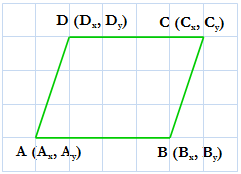A parallelogram is a quadrilateral with two pairs of parallel sides. See the picture below:

Now you are given the co ordinates of A, B and C, you have to find the coordinates of D and the area of the parallelogram. The orientation of ABCD should be same as in the picture.
Input
Input starts with an integer T (≤ 1000), denoting the number of test cases.
Each case starts with a line containing six integers Ax, Ay, Bx, By, Cx, Cy where (Ax, Ay) denotes the coordinate of A, (Bx, By) denotes the coordinate of B and (Cx, Cy) denotes the coordinate of C. Value of any coordinate lies in the range [-1000, 1000]. And you can assume that A, B and C will not be collinear.
Output
For each case, print the case number and three integers where the first two should be the coordinate of D and the third one should be the area of the parallelogram.
Sample
| Sample Input | Sample Output |
|---|---|
3 0 0 10 0 10 10 0 0 10 0 10 -20 -12 -10 21 21 1 40 | Case 1: 0 10 100 Case 2: 0 -20 200 Case 3: -32 9 1247 |


